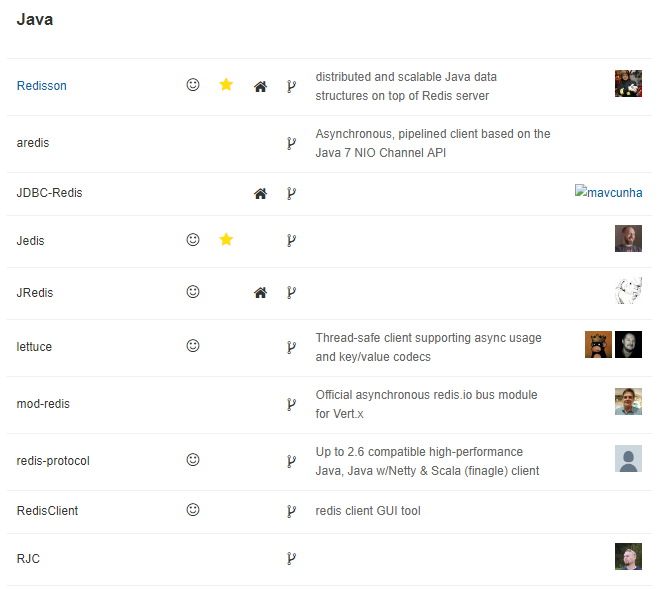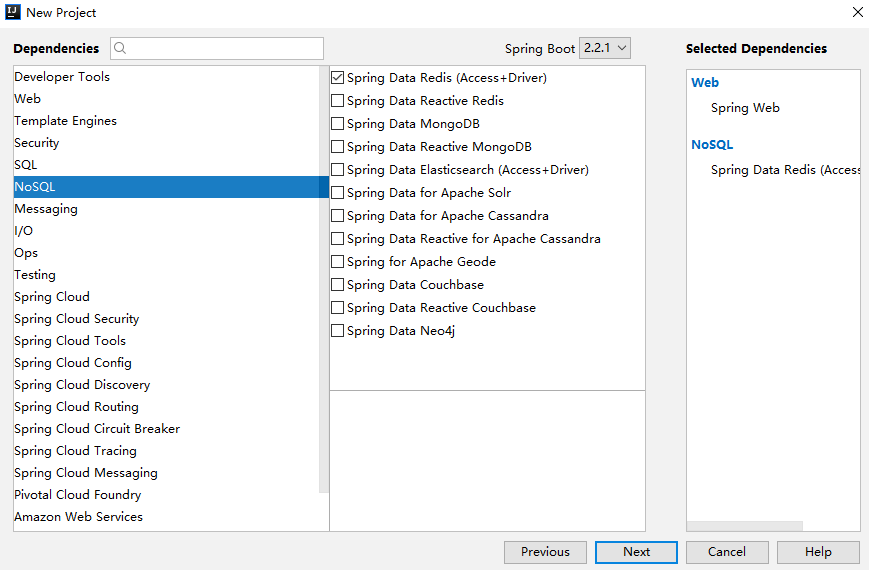Spring Boot2 系列教程(二十六)Spring Boot 整合 Redis
在 Redis 出现之前,我们的缓存框架各种各样,有了 Redis ,缓存方案基本上都统一了,关于 Redis,松哥之前有一个系列教程,尚不了解 Redis 的小伙伴可以参考这个教程:
Redis 教程合集
使用 Java 操作 Redis 的方案很多,Jedis 是目前较为流行的一种方案,除了 Jedis ,还有很多其他解决方案,如下:
除了这些方案之外,还有一个使用也相当多的方案,就是 Spring Data Redis。
在传统的 SSM 中,需要开发者自己来配置 Spring Data Redis ,这个配置比较繁琐,主要配置 3 个东西:连接池、连接器信息以及 key 和 value 的序列化方案。
在 Spring Boot 中,默认集成的 Redis 就是 Spring Data Redis,默认底层的连接池使用了 lettuce ,开发者可以自行修改为自己的熟悉的,例如 Jedis。
Spring Data Redis 针对 Redis 提供了非常方便的操作模板 RedisTemplate 。这是 Spring Data 擅长的事情,那么接下来我们就来看看 Spring Boot 中 Spring Data Redis 的具体用法。
方案一:Spring Data Redis
创建工程
创建工程,引入 Redis 依赖:
创建成功后,还需要手动引入 commos-pool2 的依赖,因此最终完整的 pom.xml 依赖如下:
<dependencies>
<dependency>
<groupId>org.springframework.boot</groupId>
<artifactId>spring-boot-starter-data-redis</artifactId>
</dependency>
<dependency>
<groupId>org.springframework.boot</groupId>
<artifactId>spring-boot-starter-web</artifactId>
</dependency>
<dependency>
<groupId>org.apache.commons</groupId>
<artifactId>commons-pool2</artifactId>
</dependency>
</dependencies>
这里主要就是引入了 Spring Data Redis + 连接池。
配置 Redis 信息
接下来配置 Redis 的信息,信息包含两方面,一方面是 Redis 的基本信息,另一方面则是连接池信息:
spring.redis.database=0
spring.redis.password=123
spring.redis.port=6379
spring.redis.host=192.168.66.128
spring.redis.lettuce.pool.min-idle=5
spring.redis.lettuce.pool.max-idle=10
spring.redis.lettuce.pool.max-active=8
spring.redis.lettuce.pool.max-wait=1ms
spring.redis.lettuce.shutdown-timeout=100ms
自动配置
当开发者在项目中引入了 Spring Data Redis ,并且配置了 Redis 的基本信息,此时,自动化配置就会生效。
我们从 Spring Boot 中 Redis 的自动化配置类中就可以看出端倪:
@Configuration
@ConditionalOnClass(RedisOperations.class)
@EnableConfigurationProperties(RedisProperties.class)
@Import({ LettuceConnectionConfiguration.class, JedisConnectionConfiguration.class })
public class RedisAutoConfiguration {
@Bean
@ConditionalOnMissingBean(name = "redisTemplate")
public RedisTemplate<Object, Object> redisTemplate(
RedisConnectionFactory redisConnectionFactory) throws UnknownHostException {
RedisTemplate<Object, Object> template = new RedisTemplate<>();
template.setConnectionFactory(redisConnectionFactory);
return template;
}
@Bean
@ConditionalOnMissingBean
public StringRedisTemplate stringRedisTemplate(
RedisConnectionFactory redisConnectionFactory) throws UnknownHostException {
StringRedisTemplate template = new StringRedisTemplate();
template.setConnectionFactory(redisConnectionFactory);
return template;
}
}
这个自动化配置类很好理解:
- 首先标记这个是一个配置类,同时该配置在 RedisOperations 存在的情况下才会生效(即项目中引入了 Spring Data Redis)
- 然后导入在 application.properties 中配置的属性
- 然后再导入连接池信息(如果存在的话)
- 最后,提供了两个 Bean ,RedisTemplate 和 StringRedisTemplate ,其中 StringRedisTemplate 是 RedisTemplate 的子类,两个的方法基本一致,不同之处主要体现在操作的数据类型不同,RedisTemplate 中的两个泛型都是 Object ,意味者存储的 key 和 value 都可以是一个对象,而 StringRedisTemplate 的 两个泛型都是 String ,意味者 StringRedisTemplate 的 key 和 value 都只能是字符串。如果开发者没有提供相关的 Bean ,这两个配置就会生效,否则不会生效。
使用
接下来,可以直接在 Service 中注入 StringRedisTemplate 或者 RedisTemplate 来使用:
@Service
public class HelloService {
@Autowired
RedisTemplate redisTemplate;
public void hello() {
ValueOperations ops = redisTemplate.opsForValue();
ops.set("k1", "v1");
Object k1 = ops.get("k1");
System.out.println(k1);
}
}
Redis 中的数据操作,大体上来说,可以分为两种:
- 针对 key 的操作,相关的方法就在 RedisTemplate 中
- 针对具体数据类型的操作,相关的方法需要首先获取对应的数据类型,获取相应数据类型的操作方法是 opsForXXX
调用该方法就可以将数据存储到 Redis 中去了,如下:
k1 前面的字符是由于使用了 RedisTemplate 导致的,RedisTemplate 对 key 进行序列化之后的结果。
RedisTemplate 中,key 默认的序列化方案是 JdkSerializationRedisSerializer 。
而在 StringRedisTemplate 中,key 默认的序列化方案是 StringRedisSerializer ,因此,如果使用 StringRedisTemplate ,默认情况下 key 前面不会有前缀。
不过开发者也可以自行修改 RedisTemplate 中的序列化方案,如下:
@Service
public class HelloService {
@Autowired
RedisTemplate redisTemplate;
public void hello() {
redisTemplate.setKeySerializer(new StringRedisSerializer());
ValueOperations ops = redisTemplate.opsForValue();
ops.set("k1", "v1");
Object k1 = ops.get("k1");
System.out.println(k1);
}
}
当然也可以直接使用 StringRedisTemplate:
@Service
public class HelloService {
@Autowired
StringRedisTemplate stringRedisTemplate;
public void hello2() {
ValueOperations ops = stringRedisTemplate.opsForValue();
ops.set("k2", "v2");
Object k1 = ops.get("k2");
System.out.println(k1);
}
}
另外需要注意 ,Spring Boot 的自动化配置,只能配置单机的 Redis ,如果是 Redis 集群,则所有的东西都需要自己手动配置,关于如何操作 Redis 集群,松哥以后再来和大家分享。
方案二:Spring Cache
通过 Spring Cache 的形式来操作 Redis,Spring Cache 统一了缓存江湖的门面,这种方案,松哥之前有过一篇专门的文章介绍,小伙伴可以移步这里:Spring Boot中,Redis缓存还能这么用!。
方案三:回归原始时代
第三种方案,就是直接使用 Jedis 或者 其他的客户端工具来操作 Redis ,这种方案在 Spring Boot 中也是支持的,虽然操作麻烦,但是支持,这种操作松哥之前也有介绍的文章,因此这里就不再赘述了,可以参考 Jedis 使用。
总结
Spring Boot 中,Redis 的操作,这里松哥给大家总结了三种方案,实际上前两个使用广泛一些,直接使用 Jedis 还是比较少,基本上 Spring Boot 中没见过有人直接这么搞。
好了,本文就说到这里,有问题欢迎留言讨论。
相关案例已经上传到 GitHub,欢迎小伙伴们们下载:https://github.com/lenve/javaboy-code-samples
·······················
欢迎关注专栏:
**《Spring Cloud微服务开发实践》
共同学习,写下你的评论
评论加载中...
作者其他优质文章







